Netball
Rules and Regulations
GENERAL
- Netball shall be conducted under the rules of the AANA except as stated. Additional rules concerning the conduct of play apply to all netball matches played by schools who are members of the NHSSA.
- The roster shall consist of anywhere between 12 and 14 rounds with finals to follow. The roster includes Junior Girls (7/8), Senior Girls (9/10), College Girls (11/12) and Senior Boys.
- Boys are permitted to play in the Junior 7/8 Roster only.
- All matches will be played at the Northern Tasmanian Netball Centre (Northern Tasmania Netball Association (Hoblers Bridge)) unless notified otherwise.
- Where teams from the same school are rostered to play each other, the match can be played on an alternate day at your school. Please inform Executive Officer (EO) if this is the case and forward results as soon as practicable.
- The first three rounds of the roster are considered seeding rounds and if there are any changes to be made an updated roster will be resent after this round.
- Divisions within rosters will be made as equitable as possible.
- Rosters, Results and Other Information will be available on the NHSSA website. PLAYHQ will be in operation for 2024.
TIMING
- Saturday games consist of four (4) ten-minute quarters, with a 3-minute break at half time and a 2-minute break at quarter and three-quarter time.
- Match games are 8.00am and 9.00am
- Wednesday and Thursday games consist of four (4) eight-minute quarters, with a 3-minute break at half time and a 2-minute break at quarter and three-quarter time.
- Matches are scheduled to start at 1.00pm and 1.45pm.
- There will be central timing, so it is important to monitor the time to ensure you are ready to start each quarter.
- If an injury occurs the clock will not stop due to central timing. If an injury precludes a player being removed from the court, at least half of the prescribed playing time must be played for a result to stand.
- Matches must start on time whether all players are present or not. The missing player(s) may not come into play until a goal has been scored and the umpire notified. The interchange rule will apply (27).
- A forfeit will occur if a team has not taken the court with a minimum of five (5) players 10 minutes after the scheduled starting time.
UMPIRING/SCORING/RESULTS
- Each team must provide an umpire and scorer. More experienced umpires should umpire the higher divisions.
- Scoresheets will be provided. These can be collected from the main admin building.
- Each team should keep a record of the scores for their own records but are to sit together while scoring to ensure accuracy. Please check at the end of the game that you have the same score (preferably at the end of each quarter)
- Bothcoaches must agree on the scores at the completion of each game.
- Resultsare to be delivered to the admin building and placed in the NHSSA In tray for a NHSSA representative to collect at the end of the Round. It is advisable to photograph the score sheet for your own records.
- Points for roster games to be allotted as follows:
Win – 5 Points
Draw – 3 Points
Loss – 1 Point
Wash Out 3 Points
Forfeit (Win) 5 Points
Forfeit (Loss) 0 Points
- Results will be updated to the website/PLAYHQ as soon as possible
STANDARDS OF DRESS AND BEHAVIOUR
- Positional bibs must be worn. The NHSSA has two sets of spare bibs if required.
- Teams are expected to meet the normal netball standards of dress. School specific netball uniform requirements/no jewellery etc. It is preferable that all jewellery is removed however new piercings/medical piercings can be covered.
- Please ensure there is an adult attached to each team for supervision purposes, preferably a teacher.
- It is vital that all players treat the venues with respect. Any vandalism/smoking/vaping will mean our privileges being withdrawn. Offenders caught will be barred from the centre.
PLAYER ELIGIBILITY
- Teams shall consist of 7 court players and players are only permitted to play in one team per round unless urgent fill ins are required, remembering players can only move up to fill in, not down.
- Interchange players can be freely interchanged. Rolling subs are permitted as per the new Netball Aus rules. All players’ names, including interchange, must appear on the score book prior to the commencement of play. Any reserve player who takes the court should also have their name on the score sheet.
- Where a player has played more than half a roster in a higher division, they shall not continue to play in a lower division.
- A player must have played at least half the roster games for a team to qualify to play for finals for the same team. *If a school has two or more teams in one Division and one of those teams qualifies for the Grand Final, the players selected for the Grand final team must have played at least half the rostered matches for that team.
FINALS
- This applies to all WEDNESDAY, THURSDAY, AND SATURDAY FINALS
- Semifinals1v4 and 2v3 play off. The winners play off in the GF.
- If a semifinal is drawn, then the team occupying the higher spot on the ladder shall go through to the GF.
- Grand Final – In the case of a draw extra time is played (3 min each way). At the change, teams change straight over with no coaching allowed. If scores are still tied after extra time, then the premiership is awarded to the team who finished higher on the ladder at the completion of the roster matches
- A copy of the team list showing all team members and the number of games they have played in that team must be made available to the opposing team and Executive Officer on request prior to the Grand Final.
- If a final is washed out after two attempts at playing, then the pennant will be awarded to the team who finished on top at the end of the roster season.
FORFEITS AND CANCELLATIONS
- Generally, PICs of netball will be informed if there are cancellations due to weather or forfeits from teams as soon as practicable. It will be PIC’s responsibility to then inform their teams and coaches.
FORFEITS
- A forfeit will occur if a team has not taken the court with a minimum of five (5) players 10 minutes after the scheduled starting time.
- If you need to forfeit prior to match day, please notify NHSSA EO as soon as possible to give every opportunity for the opposition to be informed (preferably prior to the end of previous school day.
CANCELLATIONS
- For Saturday games – if the weather forecast is extremely foreboding games will be cancelled on Friday afternoon.
- For Wednesday and Thursday – games will be cancelled, and schools notified by 10.00. If schools need to leave prior to 10.00am an attempt will be made to notify earlier.
- For Saturday morning cancellations PIC’s will be notified and notifications will be placed on the website and Facebook page (when constructed).
- If games have not been cancelled officially, but heavy rain begins falling during or just before the game, the game can be called off if either team refuses to play due to safety considerations.
- Common sense mustprevail in such a situation. If there is still strong disagreement, then the Executive Officer shall have the final say and both teams then must abide by that ruling. In the case of a match not proceeding because of bad weather 3 pts will be awarded to both teams.
SAFETY AND WELLBEING
- First Aid personnel will be on site at the Netball Centre on Saturday morning (located in Admin building on the lower courts); however, it is advisable for coaches/managers of teams to have their own first aid kit for their team/s.
- First Aid facilities will not be supplied at either school or non-school venues on Wednesday or Thursday afternoons. According to the current DECYP policy, schools are encouraged to have a first aid qualified person in attendance and at minimum a fully stocked first aid kit.
- It is important that coaches/managers be aware of any specific medical conditions or needs of their players and have the necessary individual medication on hand.
- Students’ safety and wellbeing is always a priority so if you have any concerns or questions, please do not hesitate to call me, Rachel Buck – Executive Officer, on 04047432329.
COURT LAYOUT
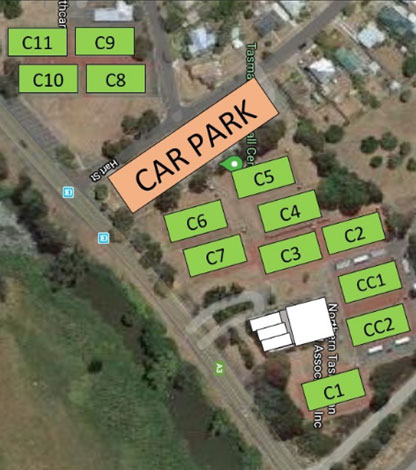
BASIC RULES OF THE GAME
Netball Positions
In a standard game of netball, a team has 7 players on court at one time. They take up the following positions:
Goalkeeper
Allowed in the defensive goal third and shooting circle
Goal Defence
Allowed in the defensive and centre thirds, and the shooting circle
Wing Defence
Allowed in the defensive and centre thirds, but not the shooting circle
Centre
Allowed in all thirds, but not in either shooting circle
Wing Attack
Allowed in the attacking and centre thirds, but not the shooting circle
Goal Attack
Allowed in the attacking and centre thirds, and the shooting circle
Goal Shooter
Allowed in the attacking goal third and shooting circle
See how they line up and which areas of the court each position is allowed to play in below:

Goalkeeper (GK)
Goal keepers are only allowed in their defensive goal third, including the shooting circle, in order to defend their goal. They primarily mark the opposing Goal Shooter (GS).
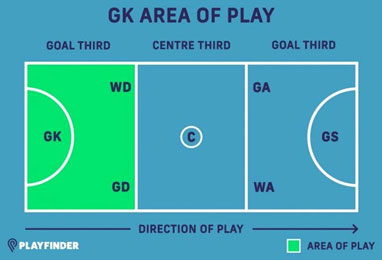
Goal Defence (GD)
A Goal Defence is allowed in both the centre third and their defensive third, including the shooting circle. They primarily mark the opposition team’s Goal Attack (GA).
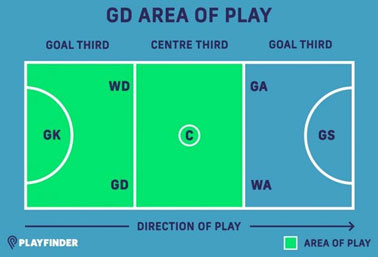
Wing Defence (WD)
Like a GD, a Wing Defence is allowed in the centre and defensive thirds, however they are not allowed in the shooting circle. They primarily mark the opposing Wing Attack (WA).
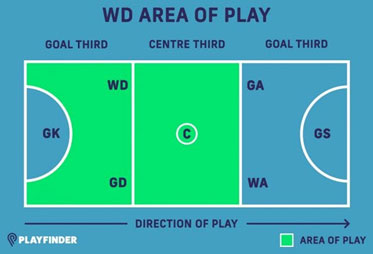
Centre (C)
A Centre is allowed in all three thirds of the netball court except for the shooting circles at either end of the court. They primarily mark the Centre of the other team.
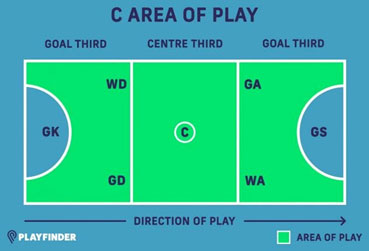
Wing Attack (WA)
The Wing Attack is allowed in both the centre third and the goal third in the direction their team is shooting, however they are not allowed in the shooting circle and therefore are unable to shoot. They primarily mark the Wing Defence of the opposing team.
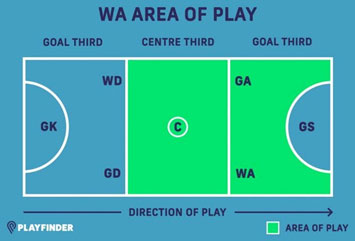
Goal Attack (GA)
The Goal Attack is allowed in both the centre third and the goal third that they are shooting towards, including the shooting circle. They are one of two players on a netball team allowed to shoot and score points. They primarily mark the opposing team’s Goal Defence.
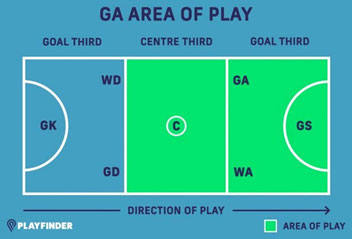
Goal Shooter (GS)
Goal Shooters are only allowed in the attacking goal third, including the shooting circle. Along with the Goal Attack, they are the only other player allowed to shoot at the net to score for their team. They primarily mark the other team’s Goalkeeper.
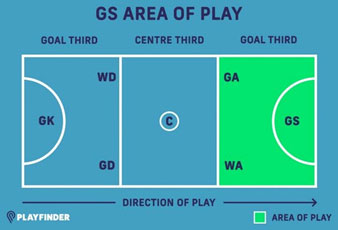
Netball Rules
Now you know about all the positions, it’s time to learn the netball rules of play.
Objective
The objective of netball is to score more points than your opposition. This is achieved by scoring goals through the nets positioned at either end of the court. You get one point for every goal you score.
Match Structure
According to standard netball rules, matches are split into four quarters. Each quarter lasts 15 minutes (amateur matches may be shorter) with a 5-minute break between the 2nd and 3rd quarter (half time). The teams switch ends after each quarter.
Match start and restart
The match starts with a centre pass, which is taken by the Centre in the centre circle. Other than the opposing Centre, all players must start in either their defensive or attacking goal third, defending on their position e.g., a Goal Defence must start the match in their defensive goal third.
When the umpire blows the whistle to signify the start of play, the Centre will attempt to pass the ball to a teammate. The ball must be caught in the centre third. If a player receives the ball in the goal third without it being touched in the centre third, the other team is awarded a free pass.
After a goal is scored, players return to their starting positions and another centre pass is taken. The teams take alternate centre passes, regardless of which team has just scored.
Footwork and passing the ball.
When a player in is possession of the ball, in accordance with the netball rules, they must pass to a teammate or shoot within 3 seconds. If they fail to do this, the ball goes to the other team for a free pass. This is referred to as a held ball.
Players are also not allowed to throw the ball from one goal third to the other goal third without it being touched in the centre third. This results in a free pass for the other team.
As well as the three-second rule, players aren’t allowed to replant their landing foot if they choose to raise it from the ground. This means that they can take one step with their free leg and raise their landing foot off the ground, however they must pass the ball or shoot before their foot touches the ground again. Players are also able to pivot with their free foot to manoeuvre into a better passing position. The other team gets a free pass if a player replants their landing foot. This is referred to as footwork.
Shooting
Goal Attack (GA) and Goal Shooter (GS) are the only players allowed to shoot and score goals. Shots must be taken within the shooting circle, sometimes referred to as the D or semi-circle. The ball must pass through the net from above for a goal to be awarded. When a goal is awarded, play restarts with a centre pass.
Obstruction and contact
According to netball rules, the sport is not strictly a non-contact sport, however contact is only allowed when not impeding an opponent or general play. When a player is in possession of the ball, their opponent must stand at least three feet away from them when marking. If the player is impeded, an obstruction is called, and the offending player must stand ‘out of play’ while a penalty pass or shot is taken.
A player can decide to carry on with their pass or shot while being obstructed by their opponent if they think they will gain an advantage. If they complete a successful pass or shot, the umpire will play advantage and play will continue. If the pass/shot is unsuccessful, the umpire will stop play and bring it back for a penalty pass or shot.
Offside
When a player retrieves the ball in an area of the court they’re not allowed to be in (e.g., the Centre catching the ball in the shooting circle) this is referred to as offside. A free pass is awarded to the opposition team for an offside call.
While a player may not be allowed to enter a certain area, they may lean on the ball in that area. This is deemed legal as long as no part of their body touches the ground in the area.
Throw ins.
When the ball goes out of play, a throw in is awarded against the team that touched it last. This is taken in the spot where the ball went out of play. For the ball to be deemed out of play, it must make contact with the ground, or a player positioned outside the area of the court.
Netball Rules Glossary
- Advantage – Advantage is played when a player decides to carry on play despite being impeded by an opposing player. The umpire will allow play to continue if they feel that stopping play and bringing it back for a penalty pass will give the impeded player a disadvantage.
- Attacking goal third – The attacking goal third is the third of the court that a team is shooting towards. Centres, Wing Attacks, Goal Attacks, and Goal Shooters are allowed in this third.
- Defensive goal third – The defensive goal third is the third of the court that a team is defending. Centres, Wing Defences, Goal Defences, and Goal Keepers are allowed in this third.
- Centre circle – The centre circle is a small circle in the middle of the court that the Centre must throw the ball from at the beginning of the match and from every centre pass.
- Centre pass – A centre pass is taken from the centre circle by the Centres of each team. They may pass the ball to their Goal Attack, Wing Attack, Wing Defence, or Goal Defence. The ball must be received in the centre third.
- Centre third – The centre third is the middle third of the court. All players apart from Goal Shooters and Goal Keepers are allowed in this third.
- Contact – Contact is called when a player impedes an opponent in a way that prevents them from moving freely. This includes knocking or hitting another player, or attempting to touch the ball while the other player has it. A penalty pass is award to the opposing team.
- Footwork – Footwork is called when a player moves and replants their landing leg. The other team is awarded a free pass in the position where the footwork took place.
- Free pass – A free pass is awarded to the opposing team when a player commits a non-contact infringement e.g., footwork or offside. If a free pass is awarded in the shooting circle to the attacking team, they may only pass the ball, not take a shot.
- Held ball – A held ball is when a player holds onto the ball for more than 3 seconds before passing or shooting. The other team is awarded a free pass.
- Landing foot – Your landing foot is the first foot you land on when you have jumped to receive the ball, meaning you are unable to move and reground it before passing the ball. If you catch a ball with both legs planted, the foot you decide not to move becomes your landing foot.
- Obstruction – Obstruction is called when a player marks the player with the ball at a distance shorter that 3 feet away. A penalty pass or shot is awarded to the opposition.
- Offside – Offside is called when a player receives the ball in an area of the court that they aren’t allowed to enter. A free pass is awarded to the opposition.
- Penalty pass/shot – A penalty pass is awarded when an obstruction or contact call is given by the umpire. If the penalty is awarded in the shooting circle for the attacking team, they may take a penalty pass or shot.
- Shooting circle – The shooting circles are the semi-circles (or Ds) at either end of the court. Only the Goalkeeper, Goal Defence, Goal Attack, and Goal Shooter are allowed in this area. Shots can only be taken within this area.
- Throw in – A throw in is taken when the ball goes off court. Throw ins are awarded against the team that touched the ball last and must be taken from off the court.
- Umpire – The umpires maintain the netball rules by awarding free or penalty passes and keeping track of the score. They also signify pauses and restarts in play. Most netball matches have two umpires.
